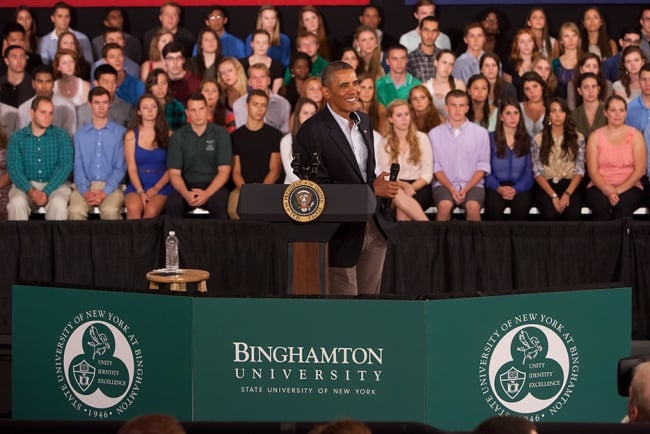You have /5 articles left.
Sign up for a free account or log in.

President Obama at Binghamton meeting with students
Photo by Jonathan Cohen
Should law school be two years instead of three? The idea has some high-profile proponents, and it got another one Friday: President Obama.
During a question-and-answer session on his higher education policy bus tour, Obama endorsed the notion as one way to reduce student debt.
“This is probably controversial to say, but what the heck, I’m in my second term so I can say it,” Obama said during a stop at the State University of New York at Binghamton. “I believe, for example, that law schools would probably be wise to think about being two years instead of three years because [….] in the first two years young people are learning in the classroom.”
In the third year, he said, “they’d be better off clerking or practicing in a firm, even if they weren’t getting paid that much. But that step alone would reduce the cost for the student.”
He continued: “Now, the question is, ‘Can law schools maintain quality and keep good professors and sustain themselves without that third year?’ My suspicion is, is that if they thought creatively about it, they probably could.”
The remarks apparently were made off-the-cuff, and no further details were available from the White House. But experts said the notion – although not new itself, as American law schools were two-year endeavors through the 19th century – is gaining traction.
Experts also agreed that Obama – a graduate of Harvard Law School and former professor of law at the University of Chicago – was correct in his assertion that the classroom-based law school curriculum could be condensed into two years, and already is at some institutions. (The saying goes that law school scares students to death in the first year, works them to death in the second, and bores them to death in the third.)
Still, the proposal leaves many unanswered questions, such as how a third-year practical component would be structured, if it would be mandatory and how beneficial it would be to students outside a university setting. Would the mentoring graduates got on-the-job, as opposed to at the clinics and formal externships that are common in the third year, be enough to prepare them for a career? Many law schools already focus much of the third year on more practical than classroom training, but students typically pay tuition for that third year, and the savings envisioned by Obama and others involve two years of tuition, not three.
And how would making law school shorter and therefore cheaper – which some legal educators said could increase law school enrollment -- impact graduates’ job prospects, which have worsened significantly of late? Experts differed in their opinions on those matters.
The two-year proposition’s biggest advocate could be Samuel Estreicher, professor at New York University Law School.
“Like many industries today, the legal profession is in the midst of a period of destabilizing change,” Estreicher wrote, along with co-author Daniel B. Rodriguez, dean of Northwestern University School of Law, in a January New York Times op-ed called “Make Law Schools Earn a Third Year.” “Myriad services are now being outsourced (often abroad) to nonlawyers, and the number of positions with large firms is dwindling, making it harder for graduating students — many of whom are saddled with six-figure student-loan debts — to find work at the outset of their careers that can even begin to pay off their obligations.”
The piece endorsed Estreicher’s standing proposal to permit law students to sit for the bar exam and begin practicing after two years, even if they have not received a law school degree. In a paper he published last year on the idea, called “The Roosevelt-Cardozo Way: The Case for Bar Eligibility After Two Years of Law School,” the professor argues for the New York Court of Appeals to revise its rules to allow that, reflecting regulations that were in place when President Franklin Delano Roosevelt and former Associate Justice Benjamin Cardozo attended law school in New York. Such a move would not only cut costs for students but also force law schools to deliver a more worthwhile third-year experience for those who still opted to complete it, he says.
One possible outcome of restructuring law schools, Estreicher argues, is that they would take a more practical, less academic bent that would better-prepare law students to begin practicing on their own upon graduation – something that’s more and more common, given businesses’ increased reliance on contract-based, rather than full-time, legal work that began during the recession and has persisted.
That could benefit legally underserved populations, addressing a frequently discussed paradox in the legal world – that even as almost half of recent law school graduates can’t find full-time jobs in law, the legal needs of large swaths of society remain unmet.
“While this wouldn’t increase the number of available jobs, a two-year option would allow many newly minted lawyers to pursue careers in the public interest or to work at smaller firms that serve lower- or average-income Americans, thereby fulfilling a largely unmet need,” Estreicher and Rodriguez wrote in the Times. “As it is now, many young lawyers say they would love to follow this path but cannot afford to because of their onerous debts.”
In an interview, Estreicher said that although there wasn’t an “avalanche” of interest in the idea, certain states’ high courts have indicated openness to allowing law schools to be more flexible. Obama’s comments – which seemed to possibly describe a one-year public service “residency” following two years of law school – could help popularize the notion, he said.
Currently, the American Bar Association requires that students graduate with a minimum of 83 credits in no less than 24 months. Estreicher said that legal intervention is needed because it’s unlikely law schools will lead the charge for change, as shaving one-third off tuition is a lot more appealing to students than it is to their institutions.
Barry Currier, managing director of accreditation and legal education for the bar association’s Section of Legal Education and Admissions to the Bar, said the idea of making law school two years is and has historically been a frequent topic of conversation. But it’s one that raises a lot of questions, he said, such as whether one means 60 credits – two academic years – or 24 months of full-time study.
Several institutions, including Northwestern, already offer the latter, accelerated law school option, with no tuition discount, he said. But addressing the former, he asked, “What would you put in 60 credits? It’s not essential that everyone takes a class in every item on the bar exam, but [essential knowledge] is certainly more than a semester-and-a-half. After that there wouldn’t be much room for skills work, for electives and for advanced course work.”
Still, he said, dramatically revamping the association’s accreditation standards to allow for more homogeneity and flexibility among law schools is a recommendation included in a recent working paper from the ABA’s Task Force on the Future of Legal Education, and the task force has discussed the 60-credit option, along with other others. The task force’s final report is expected later this year.
The Association of American Law Schools did not immediately respond to a request for comment.
Brian Z. Tamanaha, professor of law at Washington University in St. Louis and author of the book Failing Law Schools, said essential legal training easily could be condensed into two years, and that Obama’s proposal held merit.
“Many legal educators question the value of a third year,” he said. But at the same time, there’s also a push in legal education to provide students with more practical training – typically the focus of the third year -- inspired by an influential 2007 report from the Carnegie Foundation for the Advancement of Teaching. The report found law schools graduates were underprepared, lacking in professional competence and a sense of identity as lawyers. It called for a better blend of doctrinal and practical training.
Moving to two years of school followed up by a one-year apprenticeship could address both concerns, Tamanaha said. But that model’s effectiveness would depend on its design.
“Does the law school supply this service?” he asked. “It’s hard for many students to find these settings [on their own]. …A middle way of doing it would be for the law schools to be responsible for finding the placement opportunities at a substantially reduced cost.”
Still, Tamanaha said he wondered whether making law school last just two years would make for even more unemployed lawyers.
Estreicher said the question was irrelevant. It’s morally wrong to uphold an ineffective model to try to control supply and demand, he said.
Some law school deans found more fault in Obama’s proposal.
Michael Hunter Schwartz, dean of the University of Arkansas at Little Rock's William H. Bowen School of Law and author of numerous books on law school pedagogy, said in an e-mail that the practical experience, quality feedback, room for reflection and other critical skills student gain in their third year are "irreplaceable."
“Clinic and externship experiences and outstanding simulation experiences provide levels of feedback and training in self-reflection that many busy practitioners don't have the time or expertise to deliver as effectively,” he said. “There is a robust literature used by clinical legal educators on feedback and reflection that few practitioners access. These experiences in law school have a transformative effect on students and their understanding that lawyers, by virtue of their licenses from their states, owe a duty to also provide public service.”
In an e-mailed statement, John Trasviña, dean of the University of San Francisco School of Law, said that law schools do need to rethink their programs to better prepare students for the difficult job market -- but the discussion should be more qualitative than quantitative.
“The question is less about how quickly we can send them to a struggling profession than it is how well we prepare them to be successful, ethical lawyers promoting justice and worthy of the trust that clients -- corporate or individual -- place in them for representation in criminal or civil matters," he said.
One student group, the National Association of Graduate-Professional Students, opposes the idea.
"If the issue is student debt, we do not support reducing the amount of time required for a legal education," a group of association directors with law backgrounds said in a joint e-mail. "We may for other reasons, but they are not covered here. Certainly for those students who secure a job by the end of their second year, the third year frequently is criticized as 'useless' or as 'a waste of money.' But this view treats legal education as a means, and not an end unto itself. [The association] does not view education in this way. While the intellectual training may have diminishing returns after two years, the third year presently functions to shelter students while they are searching for employment after graduation by providing them with the time to enhance their qualifications by pursuing opportunities like a judicial externship, public interest internships, gaining exposure to interacting with clients through serving at one of their campus's legal clinics, or even by refining their legal writing skills when devoting most of their time to editing a journal."
Eliminating a mandatory third year also would exacerbate the "salient" criticism that law schools don't provide adequate practical preparation, they said. A better way to address student debt is to cut law school tuition, which could involve cutting law school faculty salaries.
Like Tamanaha, the student directors also said shortening law school could effectively flood the already challenging job market with new graduates, especially in the period that schools would be transitioning from three to two years.
Although it charges full tuition, Washington and Lee University's law school condenses essential legal training into two years, leaving a third year entirely for practice through clinics, supervised externships and practicum classes, or “simulations,” with top lawyers.
“About five years ago we announced the revision of our curriculum for our third year, for it to be completely practice-based – no more lectures or classes,” said Peter Jetton, a spokesman for the law school. “We put students in realistic roles, solving problems for clients in different kinds of practice settings, doing things that are litigation-based and transaction-based.”
Although revising the curriculum meant that students could take fewer electives, “We felt like it was a trade-off worth making to ensure that students were leaving school with more practical experience.”
Washington and Lee still charges regular third-year tuition because it’s expensive to run pro-bono clinics, pay people to oversee externships and hire lawyers to run simulations, Jetton said – Washington and Lee isn’t saving money on its new model, which was announced before the recession.
It’s too soon to tell whether the reconfiguration has helped boost enrollment or graduates’ job prospects, since law school applications have declined overall since the economic downturn, and the first group to complete the entire three-year program only recently graduated, Jetton said. But applicants have cited the third-year design as a reason for considering Washington and Lee.





